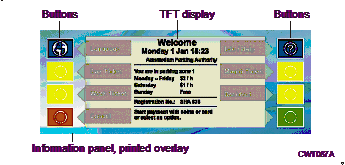The CWT 2110 and CWT 2115 models have eight fixed push buttons of the piezoelectric type – four on each side of the display window. The function of the buttons changes dynamically depending on the current phase of a purchase or information retrieval. The current function of a button is indicated by an adjacent caption or instructive text in the display.

Figure 35, CWT 2110 and CWT 2115 function buttons, example
The eight buttons on the left and right side of the display are normally set up to forward the clicks to the display panel that is currently presented. The function of each physical piezo button then depends on the defined click action of the button declaration in the current panel. This makes it possible to adapt the function of the buttons to each panel.
The CWT 2115 also has a 41-key alpha-numeric piezoelectric keyboard positioned below the display.

Figure 36, CWT 2115 keyboard, example
Behind the visible keyboard there is a fixed grid of 41 piezoelectric switches, and the function of each switch can be defined. The function of an alpha-numeric key is fixed, which means that it can not be adapted for each display panel in the user interface.
All buttons are mapped by declaring a KeyboardButton control in the Keyboard element of a display form. Each physical button in the piezo keyboard has a unique number that is used as an id of the keyboard button. This id is used as a reference when the keyboard button is defined. Each keyboard key has a Click property and a KeyValue property that specify the behaviour of the button.